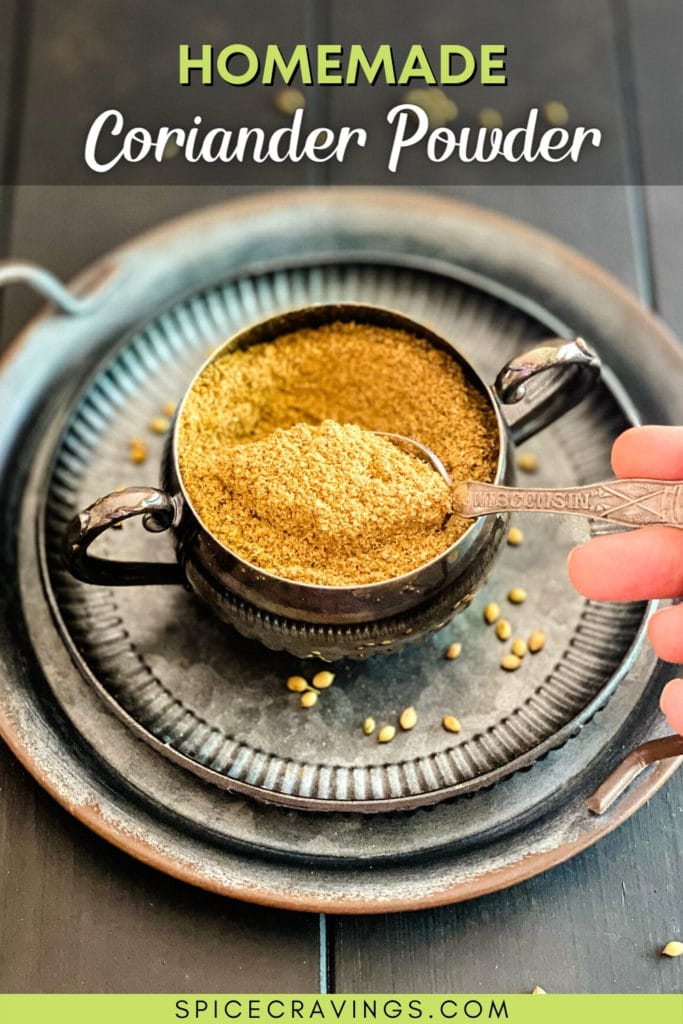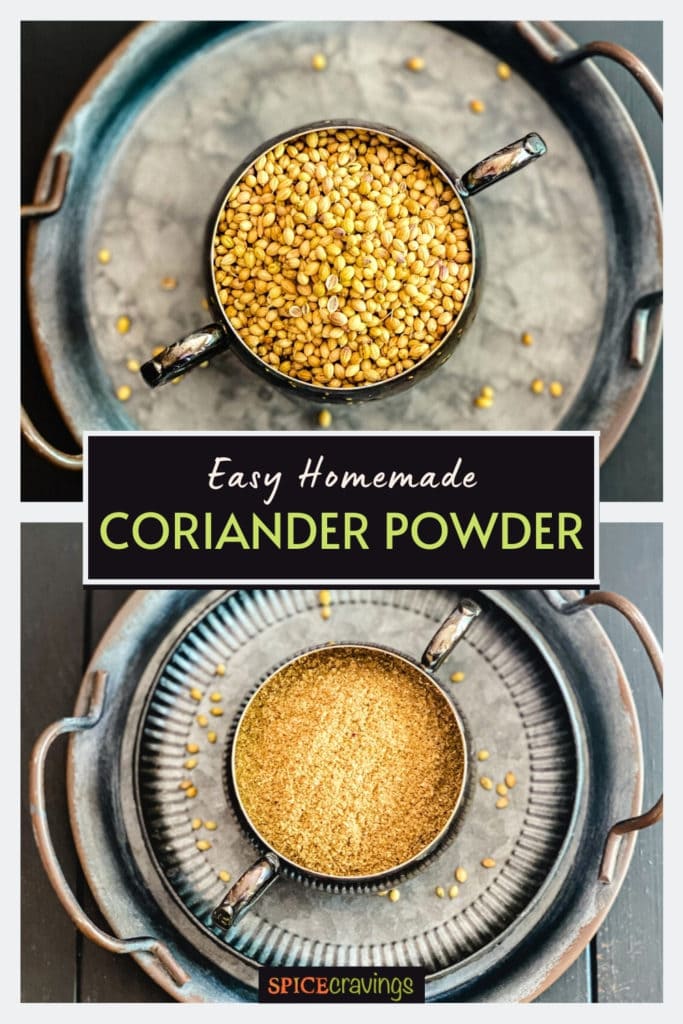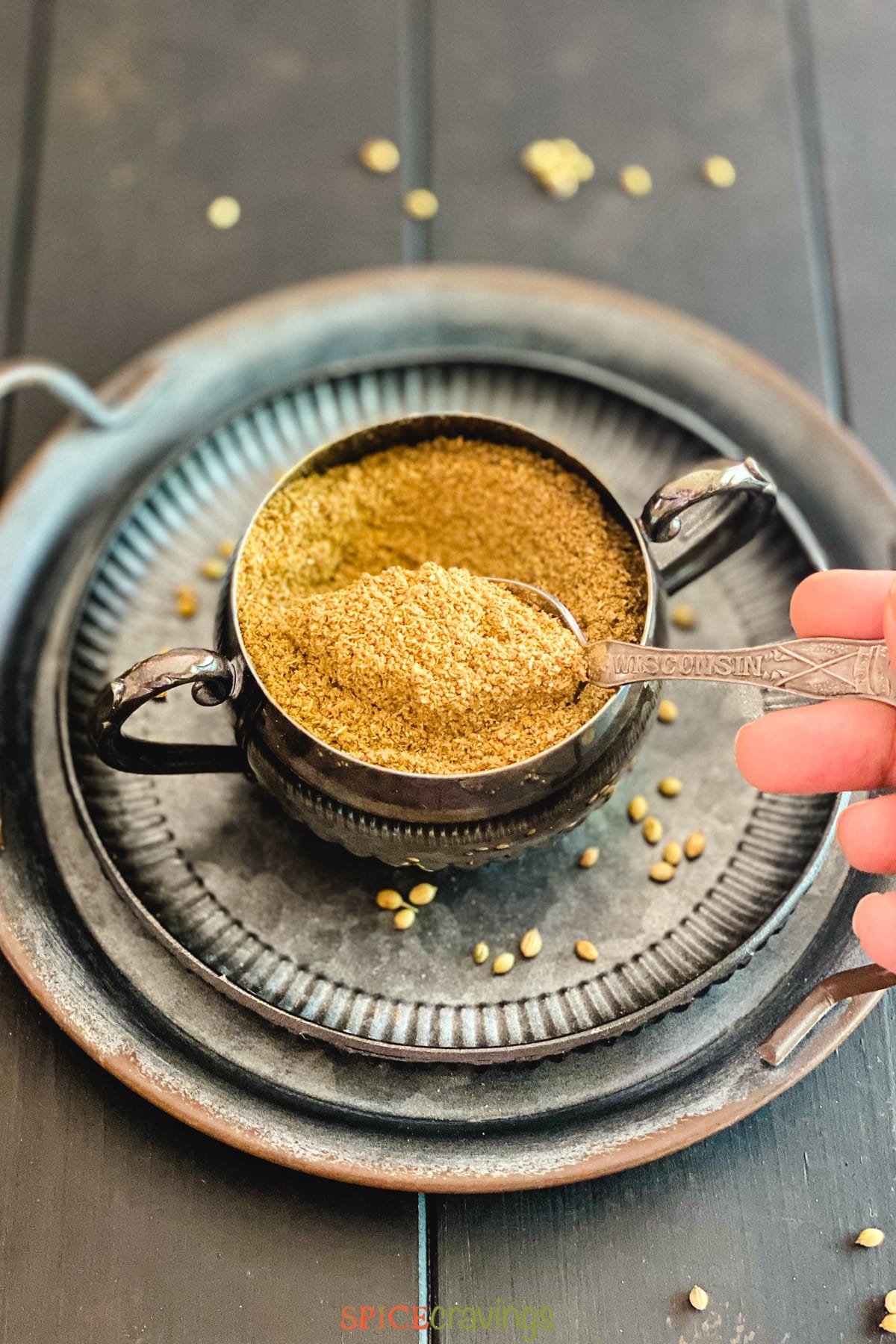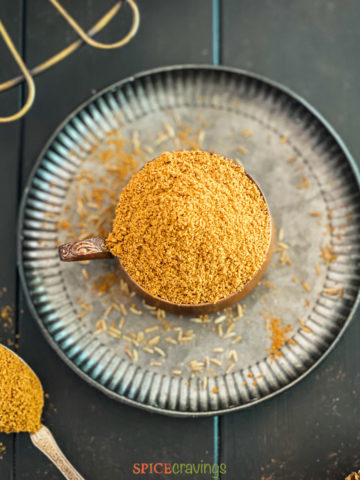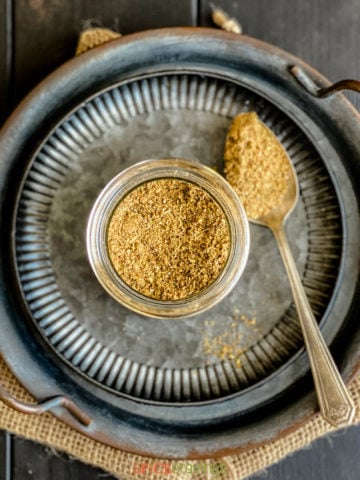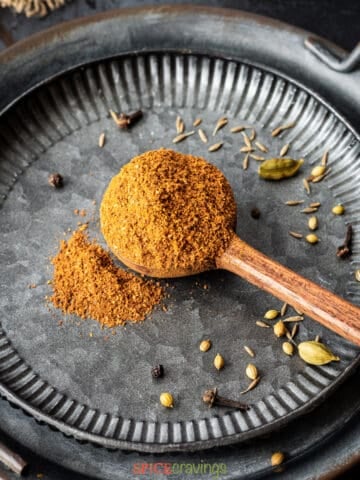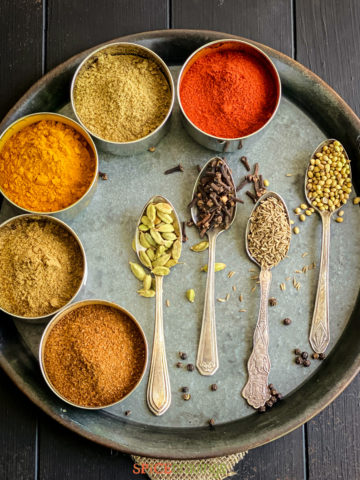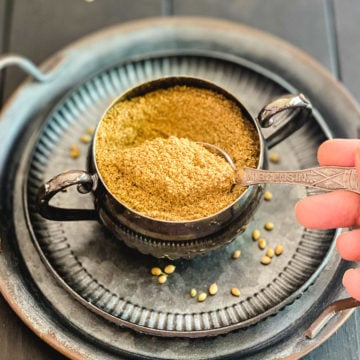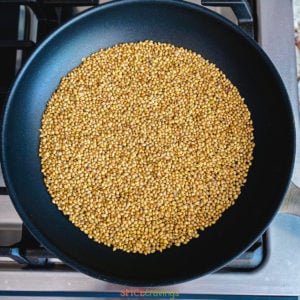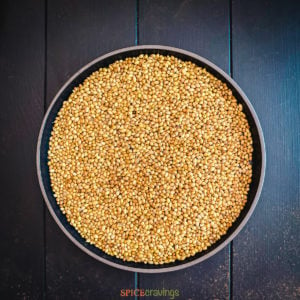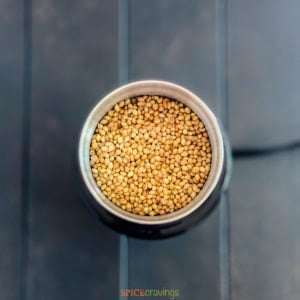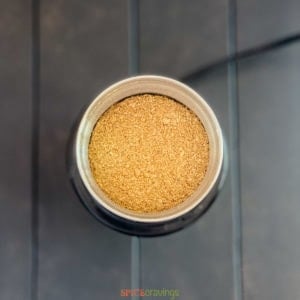Ground coriander, or coriander powder, is a must-have in my kitchen! I use it extensively in a variety of dishes across cuisines.
I highly recommend using homemade ground spices since they taste fresher, are of superior quality, and elevate the taste of any dish you make. And just like my homemade cumin powder, this coriander powder also takes just 5-10 minutes to make. Let’s take a look at this citrusy seed and its ground form.
What is Coriander Powder?
Coriander powder refers to the spice made from the round, tan-colored coriander seeds of the plant Coriandrum sativum, a member of the parsley (Apiaceae) family. Coriander powder is known as Dhaniya Powder in Hindi. It can be made with or without toasting the coriander seeds. Both add a different texture and flavor to the dish. While coriander seeds are mostly used for making spice blends, pickling spices, and spice pastes, ground coriander is added to curries, soups, stir-fries, and more. The term coriander can be used to describe the entire plant - seeds, stems, and leaves (but we will get to that later!). The best way to describe its flavor or aroma is nutty, floral, and lemony. It’s a mild spice that flavors the food without overpowering it.
Coriander vs. Cilantro
There is sometimes some confusion with the distinction between coriander and cilantro because the two terms are used interchangeably in other parts of the world. The name cilantro comes from the Spanish word for coriander, or Chinese parsley (I know, confusing!). Many European recipes, for instance, use the term coriander to refer to both the spice and the herb, aka coriander seeds and coriander leaves. In the United States, however, the seeds are called coriander while the leaves are called cilantro. Here is how I think about it: Coriander is the seed or spice of the plant that can be used for seasoning. Cilantro is the fresh, leafy part of the plant used for garnish and finishing touches. Fun Fact: The name coriander comes from the Greek word koris, meaning stink bug. This is likely due to the pungent aroma given off by cilantro leaves when they are bruised.
Benefits of Coriander
According to Healthline, coriander packs a wide array of health benefits, including that it:
May help lower blood sugar by promoting the removal of sugar from the blood. Is a rich source of immune-boosting antioxidants to help fight inflammation. May benefit heart health by lowering the “bad” LDL cholesterol. May benefit brain health by improving memory and reducing anxiety symptoms. Promotes digestion and gut health and it is good for liver function.
How to Make Coriander Powder
Coriander powder is an easy 2-step process - all it takes is a bit of roasting and grinding. Let’s see how it’s done. If you wish to grind it without roasting, simply skip to step 4.
Step 1: Roast Coriander Seeds
Heat a heavy bottom pan on medium heat on the stove for 2 minutes. Add the coriander seeds and dry roast the seeds, stirring continuously, for about 5 minutes, or until they become fragrant and slightly darker in color. Turn off the heat and transfer the coriander seeds to a plate to stop the cooking process. Let it cool completely for about 20-30 minutes.
Step 2: Grinding Coriander Seeds
Add cooled roasted coriander seeds to a coffee or spice grinder in batches. Pulse a few times, shaking the blender to prevent the powder from clumping. If needed, scrape the sides once in between. Continue to pulse until finely ground. Store in an airtight container in a cool dry place for up to 6 months. Don’t own a spice grinder? The seeds are soft enough that you can grind them with a rolling pin. Simply place the cooled coriander seeds inside a plastic sandwich bag and roll over until ground.
How to Use Coriander Powder
Coriander powder adds a fresh pop of flavor to many spice blends, including garam masala, curry powder, and taco seasoning. But it is also a widely used spice for meat, vegetables, rice, tacos, burritos, and so much more. Here are some of my favorite recipes with ground coriander:
Vegetable Biryani Indian Cauliflower Rice Black Bean Quesadillas Instant Pot Bean Burrito Lamb Korma
Cooking Tip: When converting whole seeds to ground, replace every 1 teaspoon whole seeds with ¾ teaspoon ground.
Where to Buy
Coriander, both the seeds and powder, can be found in the spice aisle of most supermarkets. That being said, I find it is cheaper to buy coriander at specialty Indian, Middle Eastern, Mexican or Latin American markets. I usually find good deals in bulk from online sellers, too.
Coriander Powder Substitute
If I ever run out of coriander powder in the middle of making a dish, I substitute it with the following options, depending on the cuisine:
Cumin Powder: These two spices go hand-in-hand and are similar in flavor, so simply use a 1:1 ratio (Indian, Mexican, Middle-Eastern & Mediterranean). Coriander Cumin Powder: Many stores carry a blend of these two spices, called Dhanjeera in Hindi. Use a 1:1 ratio. Garam Masala: Garam masala is a popular spice blend that includes coriander, along with additional warming spices. For every 1 teaspoon coriander, use ½ teaspoon garam masala (Indian & Ethiopian), Mexican Chili Powder: A slightly spicy spice blend with a wide array of chiles, for every 1 teaspoon coriander, use ½ teaspoon chili powder (Mexican & Latin Cuisine). Curry Powder: Curry powder is a blend of coriander and chili, along with other spices. For every 1 teaspoon of coriander, use 1 teaspoon of curry powder (Indian, Asian & Jamaican cuisine).
Substitute for Coriander Seeds: If you don’t have ground coriander on hand, replace it with an equal amount of ground caraway seeds, cumin, fennel or a combination of all three.
Storage Tips
Store coriander in a cool, dark place (such as your spice cabinet) away from heat and light. This ensures the spice lasts longer. Alternatively, store whole coriander seeds in the freezer. Whole coriander seeds are best used within a year, whereas ground coriander will last up to 6 months when stored correctly.
Tips & Notes
Quick sorting: Spread the coriander seeds in a large platter and using your fingers, look for small stones or dirt. Roast on medium heat: Coriander seeds contain oils that can cause it to burn quickly. Roasting on medium heat prevents the seeds from burning. Even cooking: Stir continuously to ensure even roasting of seeds. Cool completely: Always let the roasted coriander cool completely before grinding them. If ground prior to cooling, the steam and warm essential oils will cause the mixture to become gummy and reduce shelf life. Prolong shelf life: Store in a cool dark cabinet or drawer, away from stoves and other heat sources. This makes them last longer. Whole coriander seeds can also be stored in the freezer.
More Spice Blends on the Blog
📖 Recipe

